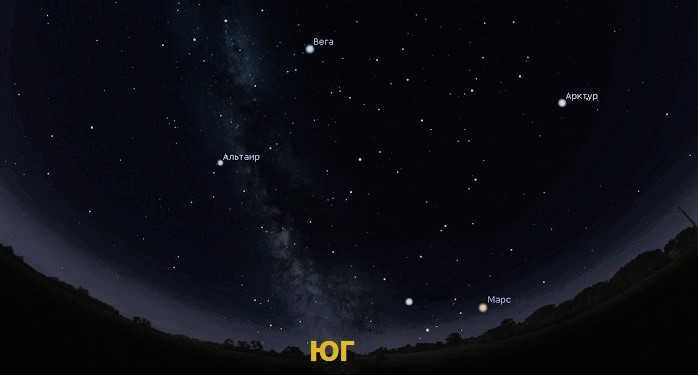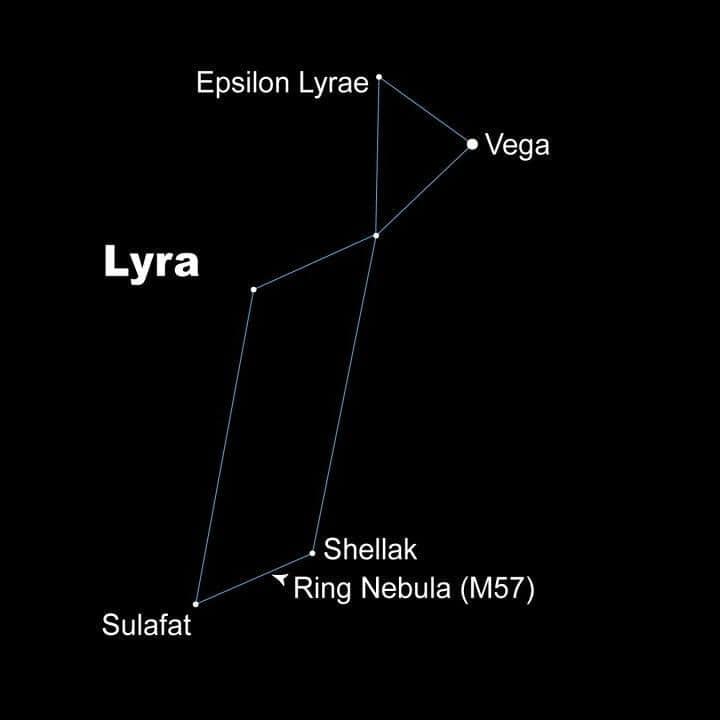The constellation Lyra is both small and stunningly beautiful, making it easily recognizable in the night sky. It can be observed throughout the year, and with the help of the brilliant Vega, locating it becomes a breeze. Despite its size, the Lyra constellation offers a wealth of fascinating celestial objects to explore.
The tale of the Lyra constellation
Lyra is an ancient constellation that can be traced back to Claudius’ constellation catalog. It has a tragic story associated with its name and origin.
According to ancient Greek myths, there was once a renowned musician named Orpheus, who was deeply in love with his wife Eurydice. When Eurydice passed away, Orpheus ventured into the realm of the dead to rescue her. Orpheus’ musical talent captivated the inhabitants of the underworld, including Charon, Cerberus, and the god of the dead, Hades. As a result, Orpheus was granted permission to bring Eurydice back to the land of the living, on one condition – he must not glance at her until they were safely out. However, overcome with doubt, Orpheus couldn’t resist looking back, causing Eurydice to remain in the realm of the dead forever.
Orpheus, filled with sorrow, roamed the earth aimlessly while strumming his lyre, until he encountered the Bacchae, a group of women devoted to Dionysus, the deity of wine. Initially, they enticed Orpheus with their charm, only to later rip him apart. Orpheus’ remains were laid to rest in Thrace, with his head finding its final resting place on the island of Lesbos. As a tribute, the god Apollo immortalized Orpheus’ lyre by placing it in the heavens, forming the constellation known as Lyra.
The arrangement of stars known as Lyra in the night sky
The star formation named Lyra is categorized as one of the constellations observed during the summer season, primarily due to its optimal visibility and position at that time. During the summer months, the prominent star Vega, which is located within the constellation Lyra, can be observed almost directly above. However, this particular constellation can be seen in Russia throughout the year, although during the winter season it appears lower on the western horizon.
During the height of summer, when gazing upwards, a brilliant star is noticeable, occasionally displaying a bluish hue. This celestial object is Vega, the primary star within the constellation Lyra. Surrounding it, a group of four stars forms the shape of a parallelogram, clearly visible to the naked eye.
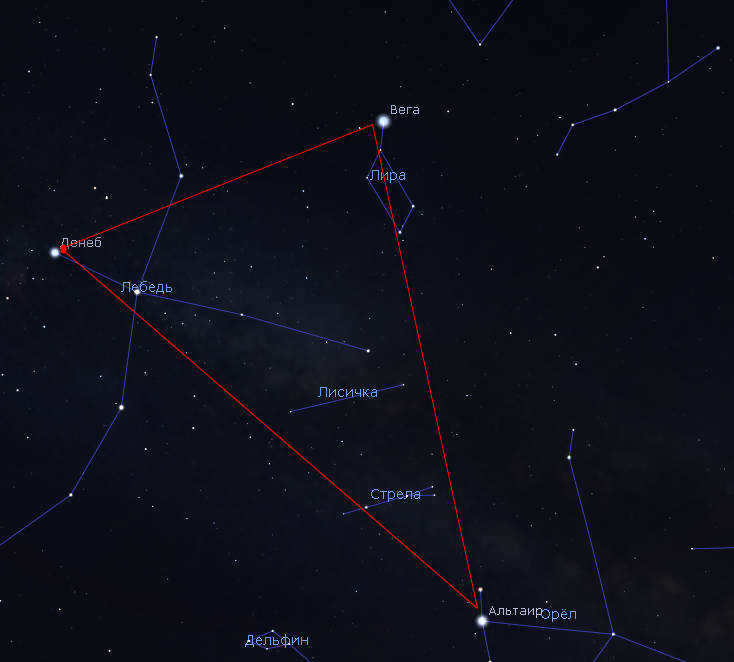
Vega is part of a constellation known as the “Lyra” in the night sky. It is also a prominent member of a group of stars called the “Great Summer Triangle,” along with Deneb, the brightest star in the Swan constellation, and Altair, the brightest star in the Eagle constellation. These three stars are easily recognizable and can be found in the summer sky.
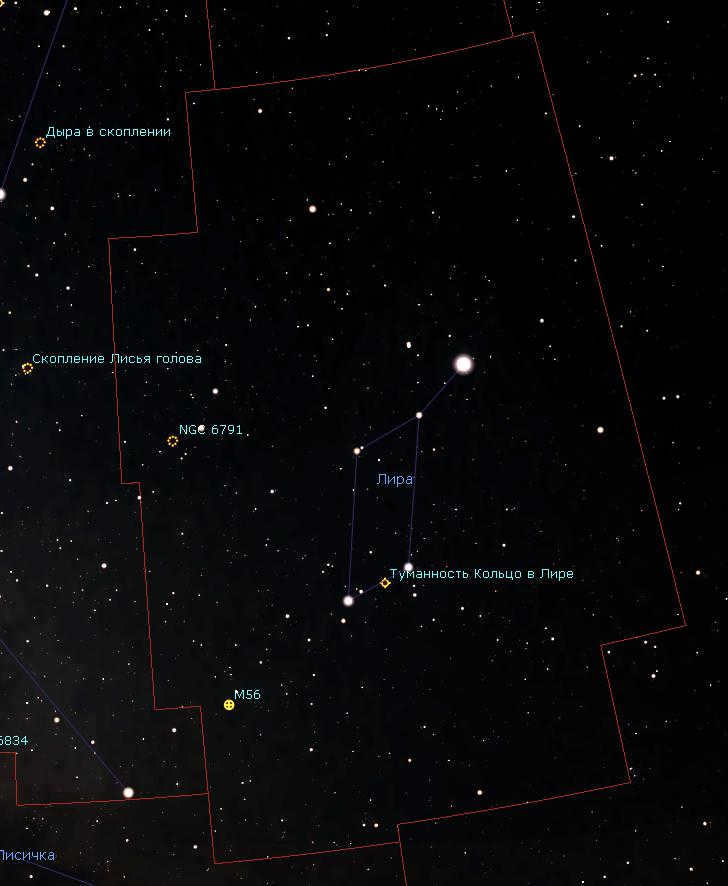
Notable Stars in the Lyra Constellation
The Lyra constellation is home to several fascinating stars. Explore below to learn more about some of its most prominent ones.
Vega: The Primary Star of Lyra
First and foremost, Vega holds the title of being the brightest star in the summer sky of the northern hemisphere, shining with a magnitude of 0.03m. Its luminosity is so significant that it serves as a reference point for measuring the brightness of other stars and is included in a specialized scale. Only Arcturus and Sirius outshine Vega, but they are visible during different times of the year. In terms of proximity, Vega is considered one of our closest stellar neighbors, located approximately 25.3 light years away.
Vega holds a special place in astronomical research, as it has been extensively studied. It was the first star ever to be captured on camera, and its distance from Earth was determined through parallax measurement by Vasily Struve in 1837.
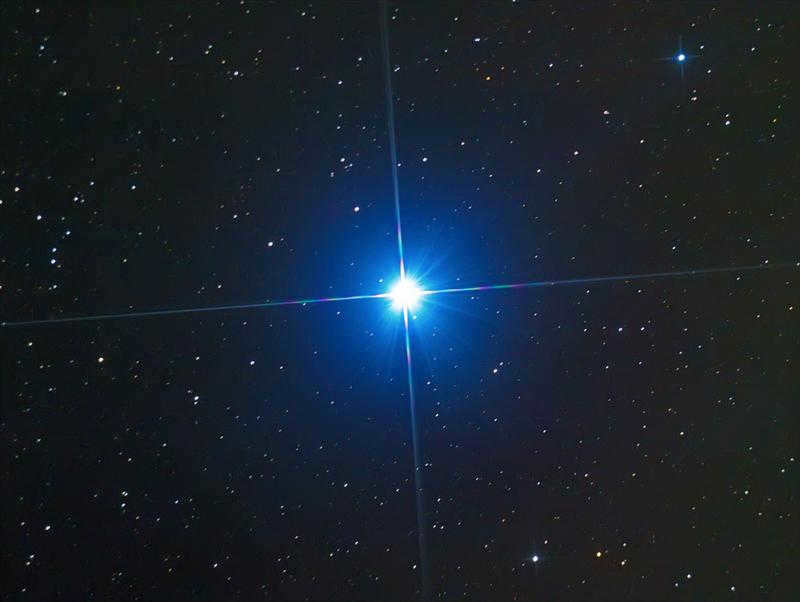
Vega is a relatively young star, with an age of approximately 455 million years. Its appearance dates back to a time long after the extinction of the dinosaurs. In terms of mass, Vega is twice as heavy as the Sun, and in terms of diameter, it is nearly three times larger. It is important to note that Vega rotates at an incredibly fast pace, spinning around its axis 100 times faster than the Sun. As a result, it has taken on a slightly flattened ellipsoid shape, with the hotter regions concentrated at its poles. From our vantage point, Vega is positioned in such a way that we see it from the pole, giving it a distinct blue-white hue.
Recent research has revealed the existence of a belt of asteroids and dust surrounding Vega, similar to the Kuiper belt found in our own solar system. Additionally, there are indications that suggest the presence of a Jupiter-like planet, although it has yet to be officially discovered. It is possible that the formation of planets is still ongoing in this region.
Another intriguing aspect of Vega is its variability as a star. While it is not definitively classified as a variable star, there are instances where it exhibits subtle fluctuations in brightness that are challenging to observe. These fluctuations can be attributed to the star’s young age and the inherent instability within its core, which may result in pulsations and alterations in luminosity. Alternatively, it is plausible that Vega is indeed a variable star, but current technology is unable to detect such minor changes in brightness.
Vega produces 40 times more light than the Sun and is significantly hotter, which means it will deplete its hydrogen supply relatively quickly. In approximately 500 million years, Vega will exhaust its hydrogen and enter the subgiant phase before eventually transforming into a red giant. Eventually, Vega will shed its outer layers and evolve into a hot white dwarf. Despite this transformation, the white dwarf will not undergo a supernova explosion due to its insufficient mass. Currently, Vega is in the middle stage of its stellar life.
If you happen to have access to a telescope, I highly recommend directing it towards Vega. Observing the radiant blue star amidst the vastness of space provides an unparalleled sense of presence and wonder.
Multiple star ε Lyrae
Epsilon Lyrae is a stellar object situated in close proximity to Vega. With the aid of sufficiently powerful binoculars, one can observe that this celestial body is comprised of two stars that are separated by a distance of 3.5′. Remarkably, each of these stars is also a binary system, resulting in a quadruple star system. The separations between the components within each binary system measure 2.8′ and 2.4′, which allows for their distinction even with a modest telescope.
Each of the four stars within the Lyra Epsilon system possesses characteristics akin to Sirius, boasting masses ranging from 1.5 to 1.9 times that of our Sun. This captivating stellar arrangement is situated at a distance of 162 light-years from Earth.
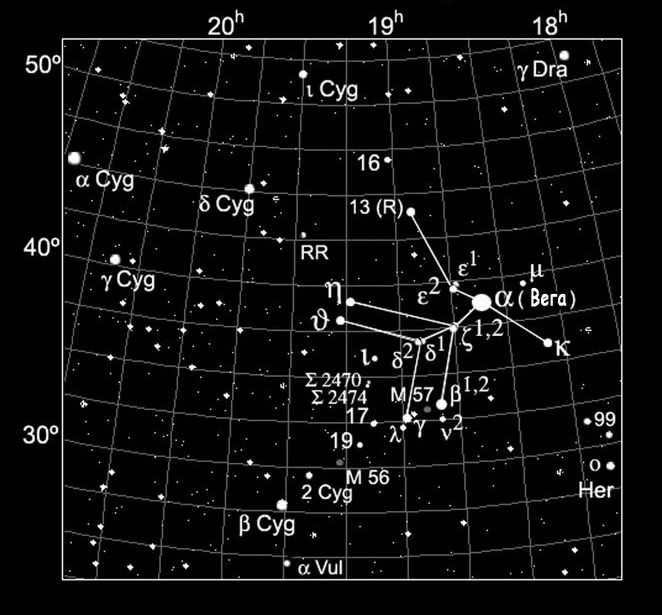
Sheliak, the beta star of Lyra, is a type of variable star that undergoes eclipses
Sheliak, also known as β Lyrae, is the second brightest star in the constellation Lyra. Located in one of the corners of the “parallelepiped” formed by Vega and other stars, this fascinating star is worth observing even without the aid of a telescope. It is situated an immense distance away from us – approximately 900 light years.
What makes Sheliak unique is that it is an eclipsing variable star, belonging to one of the most well-known and studied classes of stars in the universe. In reality, Sheliak is a binary star system consisting of two stars that orbit each other rapidly around a common center of gravity. Although we perceive it as a single star, even the most powerful telescopes cannot separate the two stars. Sheliak has an orbital period of 12.91 days.
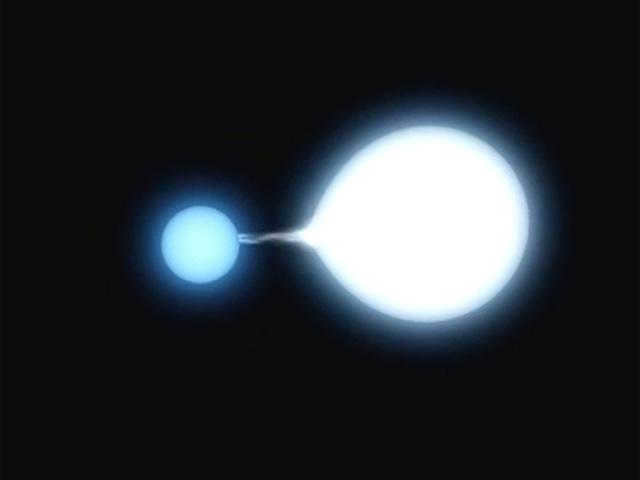
Sheliak is an eclipsing variable star.
The arrangement of these two stars is such that we observe it from the edge, resulting in a decrease in overall brightness when one star passes in front of the other. If the orbital plane had a different angle, it would appear as a regular double star to us.
The brightness of beta Lyrae varies from 3.4 to 4.3m, which is a significant change that can be easily observed with the naked eye. However, binoculars are more convenient for observations.
The Sheliak system is comprised of a pair of extremely hot stars. One of the stars is 26,000 times brighter than the Sun, while the other is 6,500 times brighter. These stars are located very close to each other, with a distance of only 40 million kilometers, which is nearly four times closer than the distance from the Earth to the Sun. The larger star has filled its Roche lobe completely, causing matter to flow from it to the smaller star. This has resulted in the formation of an accretion disk of stellar material around the system. As a result, the star that is losing matter has significantly decreased in size and now has a mass of only 3 times that of the Sun, while the other star has expanded and now has a mass of 13 times that of the Sun.
Not far from Sheliak, at a distance of 45.7″, there is another star called β Lyra B, which has a brightness of 7.2m. This star is also part of the system and can be easily spotted with binoculars. However, β Lyrae is also a double star, making the Sheliak system a quadruple system!
R Lyrae is a type of variable star
R Lyrae is situated in close proximity to Vega. It is categorized as a semi-regular variable, meaning that its minor fluctuations in brightness change in an unpredictable manner, but on average they follow a pattern with a period of approximately 50 days.
This star’s luminosity ranges from 4.0 to 5.0m, making it easily visible through binoculars. It is classified as a red giant, which is significantly cooler than the Sun with a surface temperature below 3500 degrees Celsius.
RR Lyra: An Ancestor Among Variable Stars
Within the constellation Lyra, a plethora of variable stars can be found, each belonging to different types. One such star is RR Lyra, which represents an ancestral form of variability. Unlike δ Cepheus, RR Lyrae is a Cepheid star of a distinct variety. This particular star is classified as a short-period Cepheid, with a period of less than a day. Its pulsations occur every 13 hours and 36 minutes, causing its brightness to range from 7.20 to 8.57m. Observing RR Lyrae can be accomplished with the aid of high-quality binoculars.
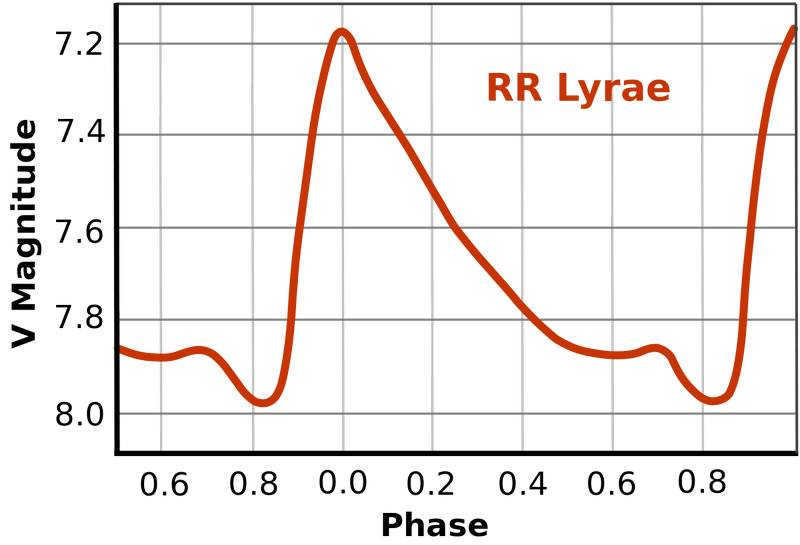
The distance to this extraordinary variable is 854 light years. Make sure to attempt to observe it.
Nebulae and clusters in the Lyrae constellation
The Lyrae constellation is notable not only for its variable stars. It also contains other exceptional objects.
The Ring, a planetary nebula M 57.
Right in the middle of the distant stars forming the “parallelogram” of Lyrae, you will find one of the most stunning planetary nebulae – it is identified as M 57 in the Messier catalog. When observed through a telescope, it appears like a fleeting ring of smoke, reminiscent of the rings blown by avid smokers. In photographs taken by the Hubble telescope, its beauty is even more striking.
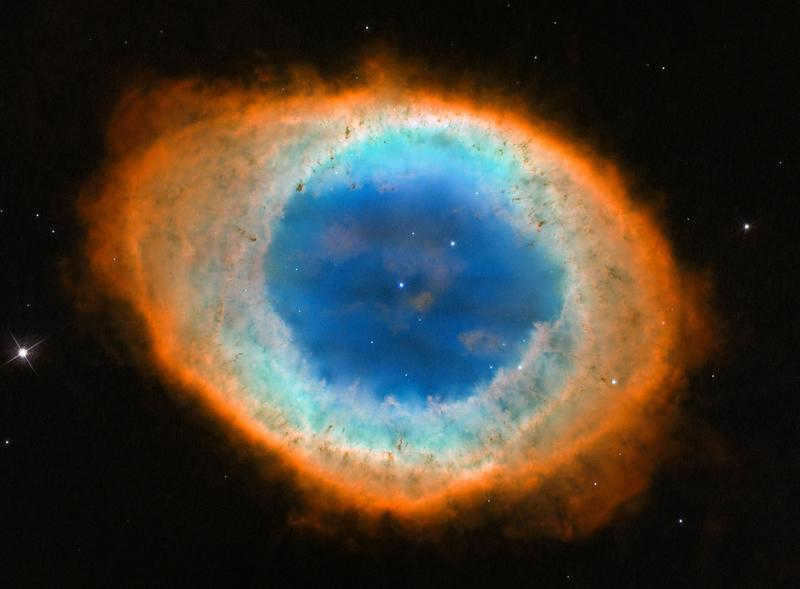
The Ring Nebula, captured by the Hubble Space Telescope, is a stunning celestial object.
This remarkable nebula originated from the expulsion of its outer layers by a red giant star at its core. Currently, this cloud of gas is rapidly expanding in all directions. The cataclysmic event that led to its formation occurred approximately 6000-8000 years ago. Over time, the nebula has grown to a diameter of 1.5 light-years, showcasing its impressive size.
The Ring Nebula shines brightly due to the ionization of gas caused by the intense radiation emitted by its central star. This star stands out as one of the hottest known, boasting a scorching surface temperature of 120,000 degrees Celsius. It outshines the Sun by a staggering 200 times, despite being only half the size in terms of mass.
The hot white dwarf with a brightness of 14.7m now resides in the center, making it a challenging object to observe even for the most powerful amateur telescopes, requiring a minimum aperture of 400 mm. However, the Ring Nebula itself can be spotted using a more modest telescope. For instance, it is clearly visible through a 90-mm refractor like the Sky-Watcher 909, and can even be detected using powerful binoculars with a brightness of 8.8m.
Although known as the Ring Nebula, it is actually a sphere, with gas expelled in all directions by the central star. However, the edges of this sphere appear “thicker” when viewed from a certain angle, giving it the appearance of a ring. Due to its flat, rounded shape reminiscent of a planet’s disk, nebulae of this kind are categorized as planetary nebulae.
If you happen to own a telescope, be sure to take a look at the M 57 nebula. It’s a fascinating sight that showcases the remnants of a catastrophic event that occurred thousands of years ago. The explosion of immense force that occurred may have obliterated any planets that once orbited the central star.
Lyra is home to the M 56 globular cluster.
Located in the constellation Lyra, the M 56 globular cluster is a remarkable celestial object. It is the brightest star cluster of its kind in Lyra, boasting a brightness of 8.3m and a size of 8.8′. Positioned approximately 30,000 light-years away, though different sources provide varying distances, it remains a captivating sight in the night sky.
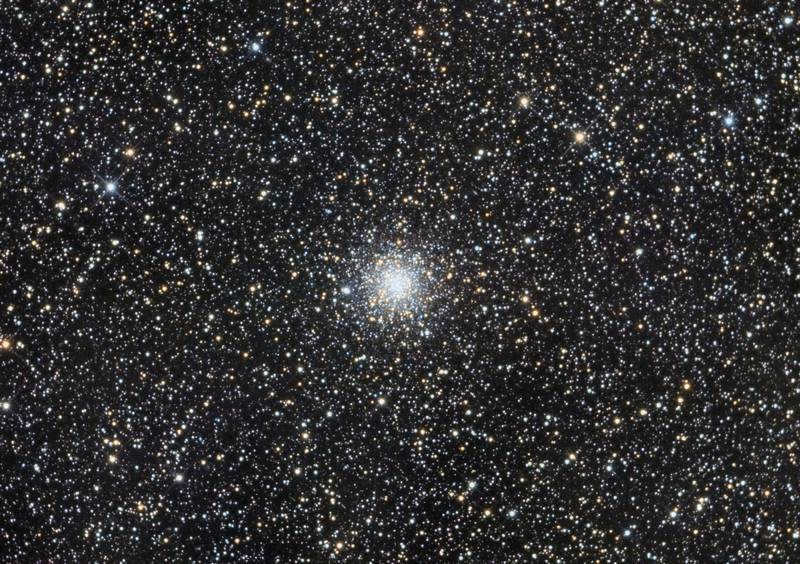
The most suitable telescope for observing this cluster is one with an aperture of at least 130mm. In smaller instruments, it is not possible to see any details. However, a telescope with a 200-mm aperture will already reveal individual stars within this cluster.
This cluster has a luminosity of 9.5m and a dimension of 16′. When observed with low magnification, it appears dim and faint, but when viewed with higher magnification, it disperses into numerous stars, resulting in a much more captivating sight. Nevertheless, due to its location amidst a densely populated background of 10-13m stars, the boundaries of this cluster are challenging to discern.
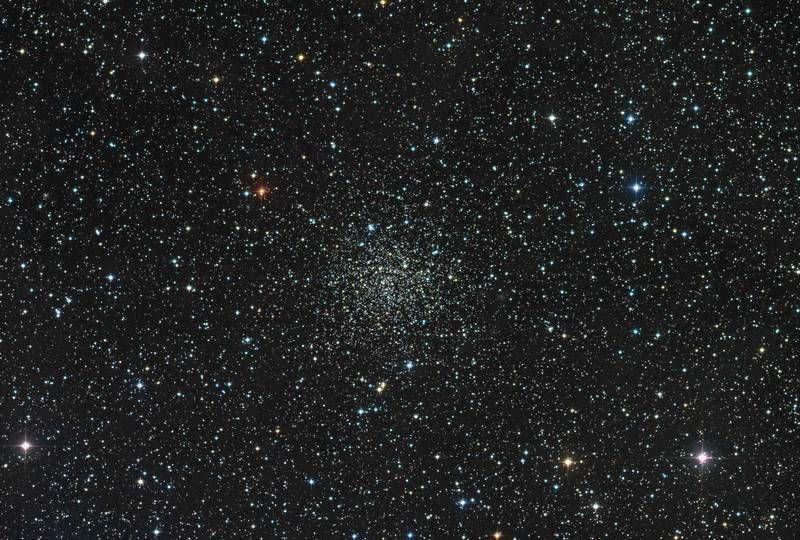
The Scattered cluster NGC 6791 is included in the constellation Lyra.
With an age of approximately 8 billion years, this cluster is considered one of the oldest. It is comprised of around 100 stars, some of which are over 6 billion years old.
Naturally, there are other celestial objects within the Lyra constellation, but the ones mentioned here can be observed with a small telescope or even without one. The Lyra constellation is particularly unique due to its abundance of attractions despite its relatively small size. So make sure to take note of it during your stargazing adventures. And may you have clear skies!
Vega, also known as the “Queen of Summer Nights,” is a prominent star that can be seen in the Northern Hemisphere from virtually any location on Earth. In Russia, it appears as a brilliant celestial body in the southern part of the sky during the early summer months. Its stunning presence has earned it the nickname “Queen of Summer Nights” due to its association with warm evenings and the enchanting beauty it brings.
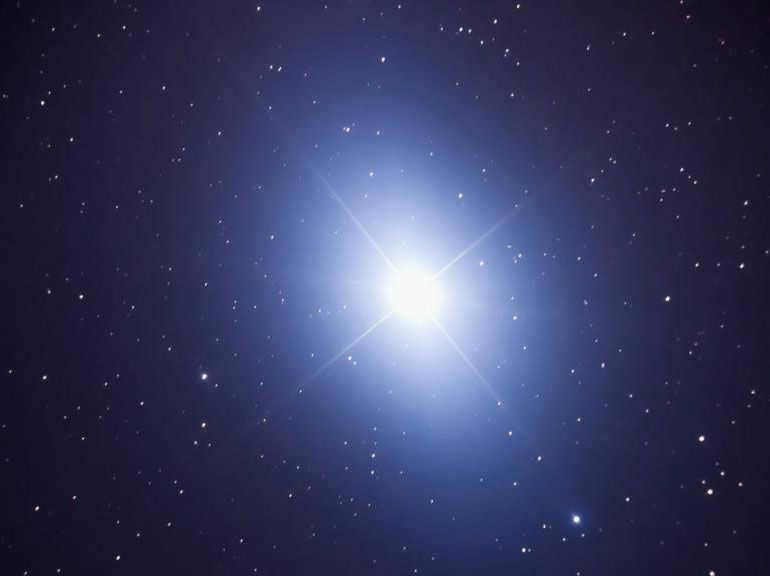
Etymology
The name of this celestial object is derived from the Arabic word waqi, meaning “falling”, or from the phrase “falling kite” (alternatively, vulture or eagle). The name Vega first appeared in the 13th century in the astronomical treatise “Alphonsus Tables”. The ancient Greeks referred to this star as Luera, while the ancient Romans called it Lyra. Claudius Ptolemy, in his work “Almagest”, referred to it as Allore.
There is no historical record of the exact date when the star was first observed and its coordinates were plotted on the celestial map. However, it was one of the earliest celestial objects that astrophotographers were able to capture, around the year 1850.
Alpha Lyra is estimated to be around 450 million years old, making it relatively young compared to the Sun, which formed much earlier. Despite its young age, the star is currently in the middle of its evolutionary life cycle, similar to the Sun.
Alpha Lyra is in a state of stable dynamic equilibrium, where the radiation pressure from its interior balances the gravitational force that compresses the star’s body.
The object nuclear reactions will occur at the center, resulting in a lifespan of approximately 500 million years. Subsequently, the luminary will undergo a transformation into a red giant, followed by the stage of planetary nebula, and ultimately become a superdense white dwarf. It is important to note that Vega lacks the necessary mass to undergo a supernova event.
Vega’s physical characteristics
Vega is the fifth most luminous star in the night sky, slightly less bright than its neighboring star, Arcturus, which holds the fourth position. However, Canopus and Alpha Centauri (ranking second and third in this list) are not visible from Russia. Among the three brightest objects visible in the night sky (either year-round or periodically) – Sirius, Arcturus, and Vega – the latter firmly secures the third spot.
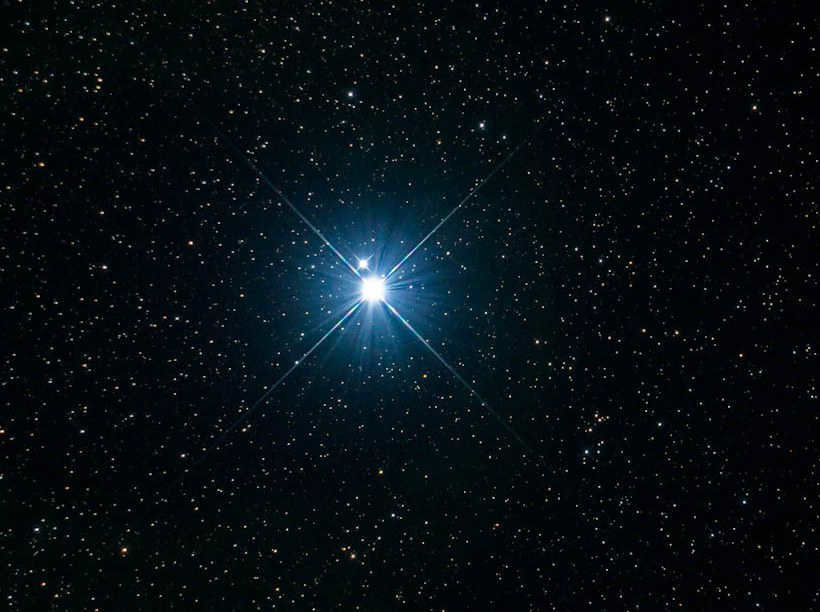
This particular star is more luminous than our Sun and can be easily seen within a distance of 10 parsecs from Earth. It has a mass that is 2.1 times that of the Sun, a diameter that is 2.8 times larger, and emits 40 times more light. However, despite these differences, Vega is actually about 10 times younger than the Sun.
Here are some key characteristics of Vega:
- type – solitary;
- spectrum class – A0V;
- color – white with a slight blue hue;
- distance from the Sun – approximately 25 light years.
Vega was formed after the Sun, but it has an interesting composition. It contains a lower amount of heavy elements (heavier than helium) compared to the Sun: only 32% of the solar abundance and just 0.4-0.5% of the star’s total mass, which is more typical of much older stars.
Features of Rotation
Vega completes a single revolution around its axis in just 17.5 hours. The equatorial sections of this star propel through space at a linear velocity of nearly 250 km / sec. This velocity is approaching the critical threshold for a star with these specific parameters. If it reaches or surpasses this critical threshold, the star will be torn apart by centrifugal forces.
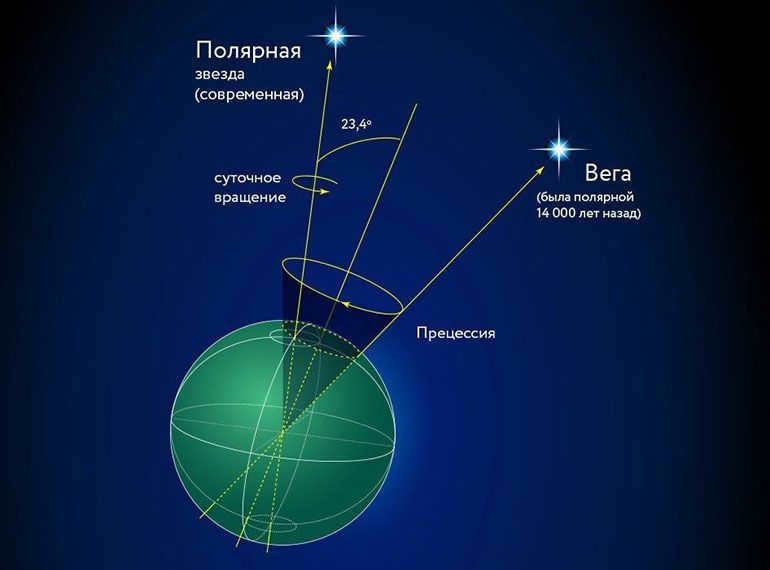
Vega used to serve as the Earth’s polar star, with the north pole pointing directly towards it. However, the star’s position in the sky has shifted as a result of our planet’s precession. Credit: uranika.ru
How to locate it in the celestial sphere
Locating this particular star in the celestial sphere is not a challenging task. There are two main approaches to spotting it: either as the most brilliant component of the Lyra constellation or as a member of the prominent Great Summer Rectangle.
Vega can be easily observed with the naked eye, but when viewed through binoculars or even an amateur telescope, its appearance becomes even more impressive – appearing as a dazzling bluish-white celestial body surrounded by numerous faint sparkling stars.
Alpha Lyra
During any summer night or early September evening, face the southern horizon of the sky and, without moving your head, lift your gaze upwards. You will see Vega. It may not be the only star in that area, but it will definitely be the brightest one.
In the second half of autumn, you should look for this star in the western part of the starry sky. In spring, it will be in the east, and in winter, it will be located in the north, just above the horizon.
At the same time, take note of the Lyra constellation to which this star belongs. It is a small but noticeable constellation. Out of its many members, only five are clearly visible: Vega and four other stars of the third and fourth magnitudes, arranged in the shape of a parallelogram below Vega. Although they are dimmer than Alpha Lyrae, they are still easily distinguishable.
Vega and the Great Summer Triangle
Between the months of May and October, Vega can be easily located as one of the vertices of a massive asterism. Alongside the stars Altair and Deneb, it creates the renowned Grand Summer (also known as Grand Summer-Autumn) Triangle. This distinctive formation can be spotted with just a quick glance at the night sky, and it appears most radiant from the beginning of July to the middle of August. Amongst its constituents, Vega shines the brightest, positioned in the uppermost corner of the asterism.
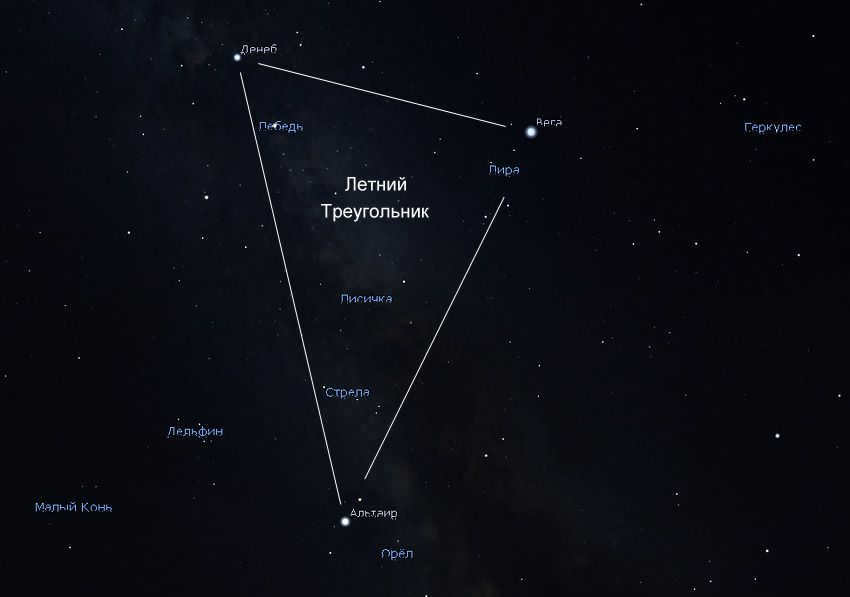
Interesting facts about Vega
There are numerous fascinating pieces of information about Vega that scientists and amateur astronomers have discovered.
The second most extensively studied star in the universe
There have been nearly 2,500 works dedicated to studying Vega, ranging from scholarly articles to comprehensive research studies, and this only includes publications from 1850 onwards.
One possible reason for its popularity is:
- Its extraordinary brightness;
- Its close proximity to our solar system;
- Its use as a calibrator for telescopes and other measuring systems, such as photometry;
- Its advantageous position in the sky.
Anomalous celestial body
The unusually high brightness and temperature of Vega (1.5 times higher than similar celestial bodies) were detected in the 1960s. Initially, it was proposed that the celestial body had a companion that added to its overall radiation, but no evidence of such a companion could be found through visual, spectral, or any other means of observation.
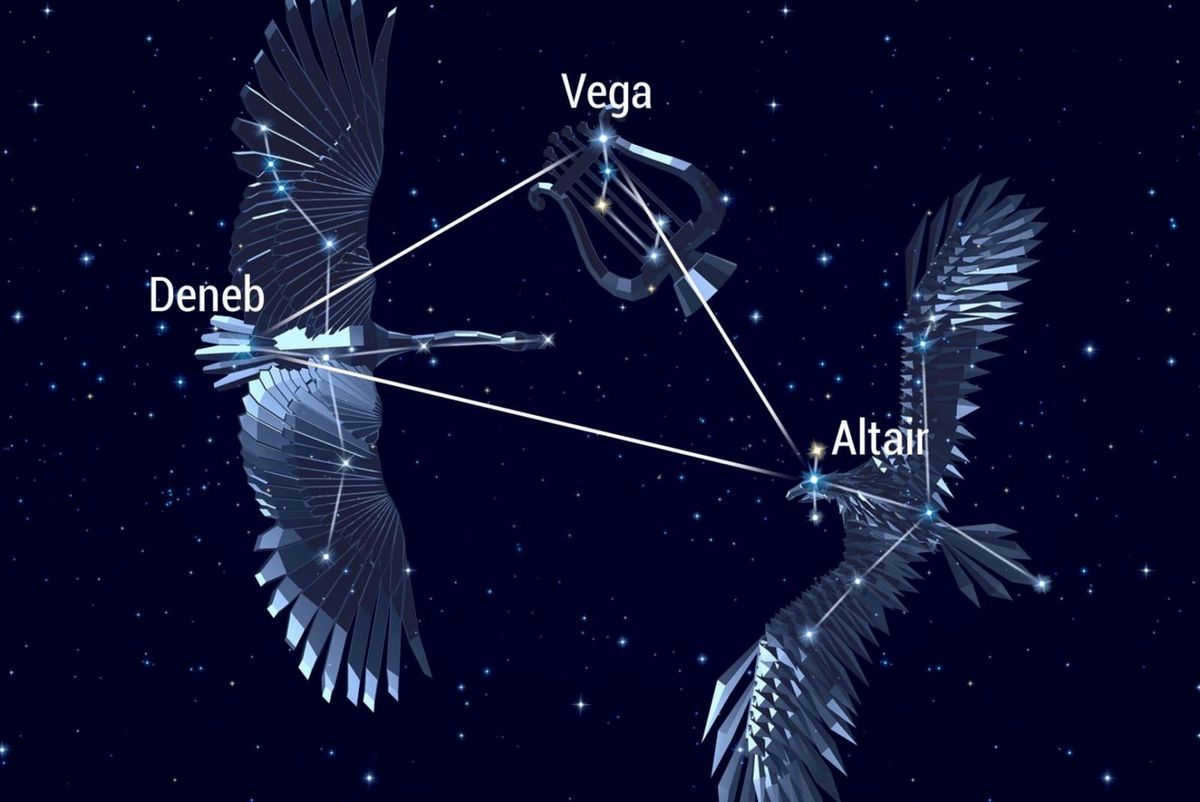
In the mid-1980s, a hypothesis emerged suggesting that the key to understanding Vega lies in its rapid rotation around its axis. Stars that rotate quickly do not have a uniform spherical shape; instead, they become flattened towards their polar regions and are commonly referred to as “wolves.”
A stellar wolf
That is the true nature of Alpha Lyrae. It spins rapidly, giving it a deformed appearance. Because the poles are nearer to the scorching core of the star than the equator, they are more radiant and hotter. A research conducted in 2005 by scientists at the Mount Wilson Observatory in California indicated that Vega is presenting one of its poles to an observer on Earth, which accounts for its unusual brightness.
In 1984, the IRAS satellite telescope made a discovery near the star Alpha Lyrae that bore a striking resemblance to the Kuiper Belt in terms of its characteristics and structure. This celestial disk encircling the star Vega had a radius of at least 550 astronomical units (a.u.) and consisted of dust and small debris. This finding provided compelling evidence that solid matter also exists beyond the confines of our solar system, in the vast expanse of interstellar space.
The configuration of this disk, with its two prominent dust nodes, could potentially indicate the presence of an undiscovered planet in close proximity to Vega, orbiting in an elongated path approximately 30 astronomical units (a.e.) away. However, despite extensive searches, this hypothetical celestial body has yet to be detected. Furthermore, recent studies utilizing more advanced techniques have revealed that the dust nodes have completely dissipated.
Vega remains and will continue to serve as a guiding star
In the past, Alpha Lyra served as Earth’s guiding star, with the north pole pointing towards it. However, Earth’s rotational axis is not fixed and undergoes precession, moving through space in a cone-shaped trajectory and completing a full circle every 25,770 years. Approximately 12.5 thousand years ago, the axis was aligned with Vega (specifically, a point 4° away from it), and this alignment will occur again in approximately 13.5 thousand years.
In the future, Vega is set to become the most luminous celestial body in the sky, second only to the Sun
As the solar system ventures through space, it is gradually making its way towards Vega, causing it to draw closer to Earth and subsequently shine even brighter. Approximately 210 thousand years from now, Alpha Lyra will surpass Sirius and take on the role of the most brilliant entity in the sky, as seen from our planet. At that point, the distance between Earth and this radiant star will be at its minimum – a mere 17.2 light-years. However, after this period, the solar system will begin to retreat, and in half a million years, Vega will relinquish its status as the brightest visible star. Finally, after a million years have passed, Alpha Lyra will no longer be visible to the naked eye of Earth’s inhabitants.
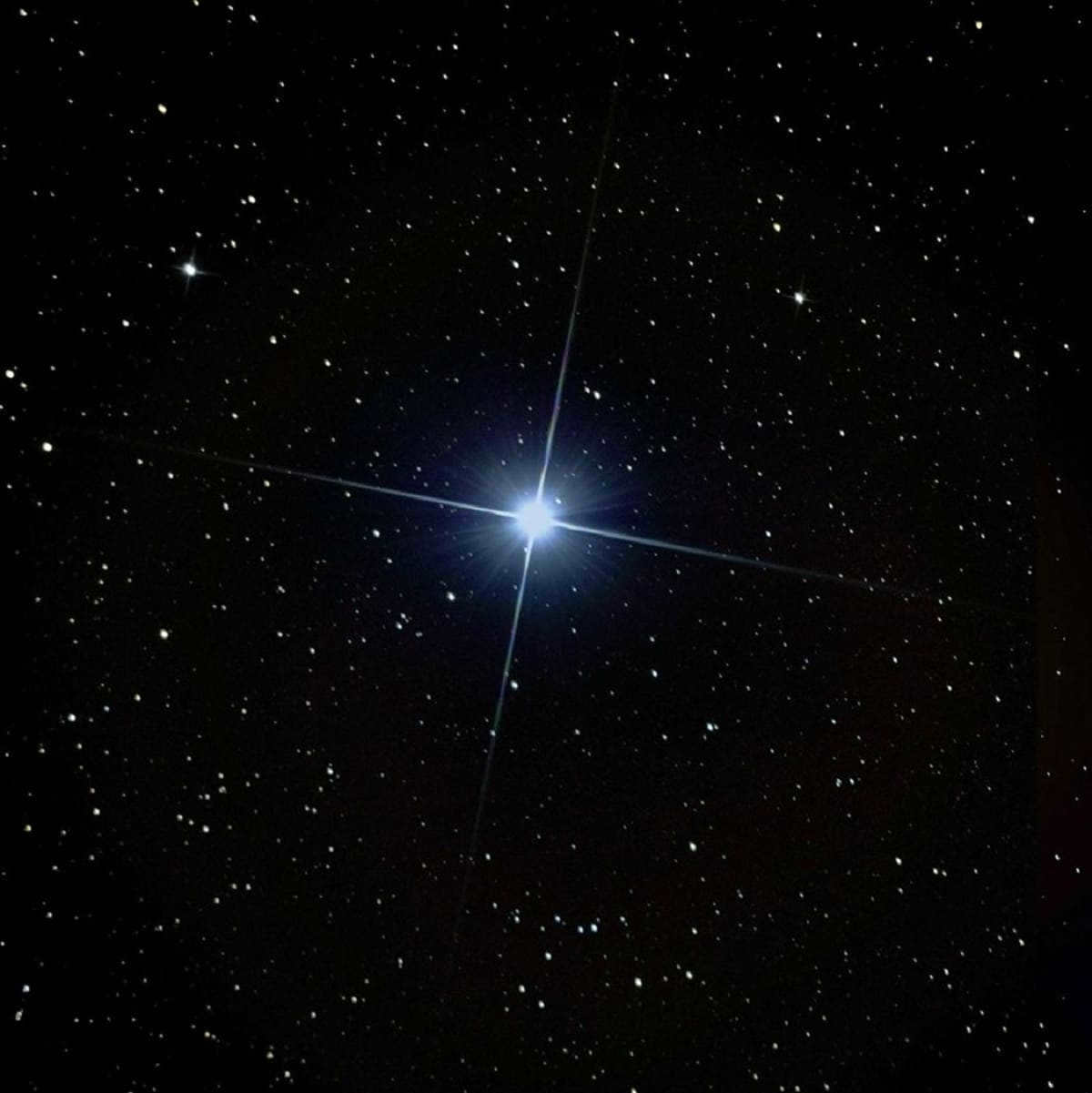
The cosmos consists of countless stars combined into constellations. Vega is one of the most well-known stars. It resides in the Lyra constellation and ranks as the fifth most luminous star in the entire nighttime firmament. It’s the second brightest star in the northern celestial hemisphere, only surpassed by Arthur. This star is a mere 25 light years away from Earth and stands as one of the closest and brightest stars to our solar system.
Within this article, we will provide you with comprehensive information regarding Vega and its distinctive features.
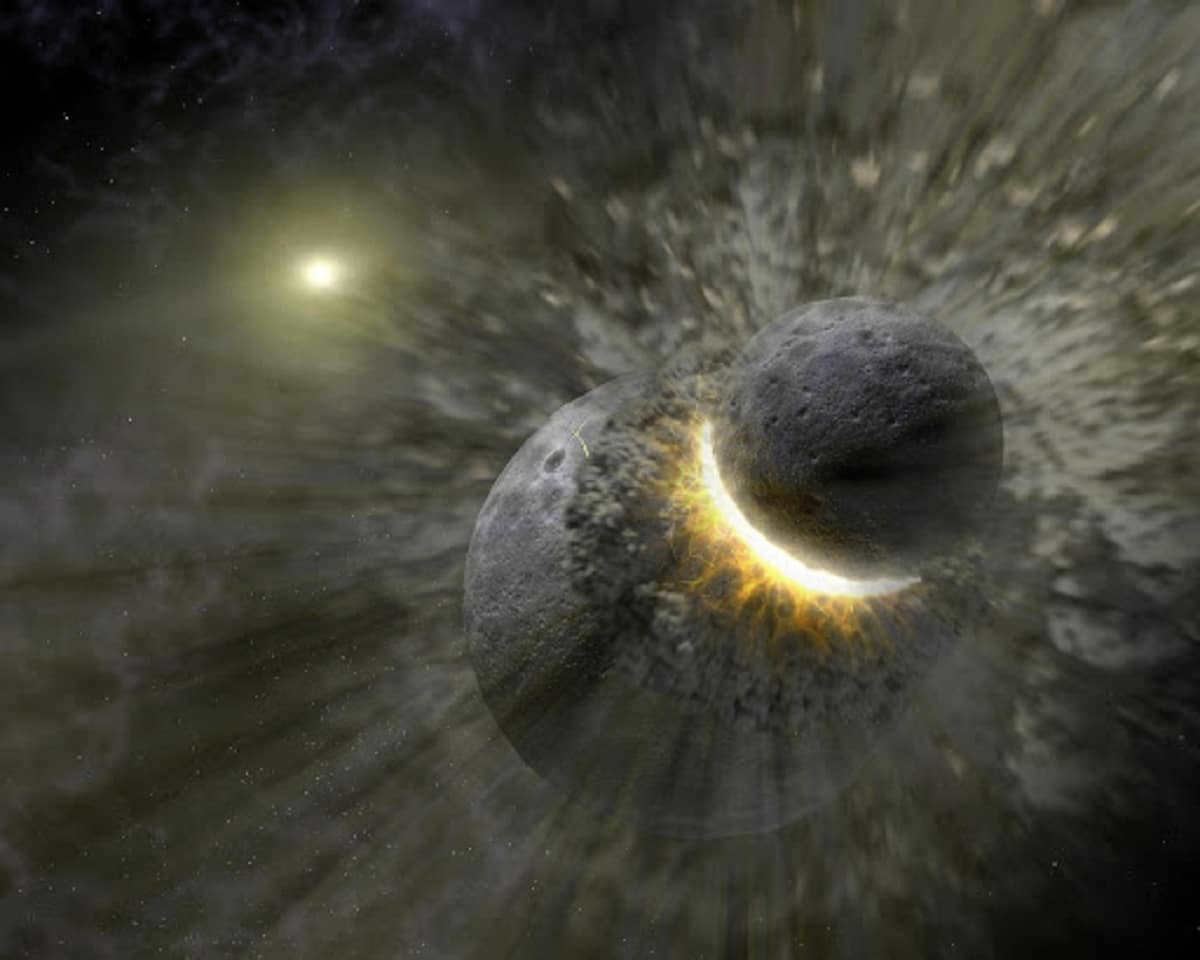
Vega, a star with a visual size and color of zero, has a BV color index of zero when the blue and green filters are subtracted. It also has an apparent magnitude of zero when viewed from the ground. Vega’s high rotational velocity, along with its significant difference in surface temperature, causes anomalous flattening. This flattening is evident in the surface temperature measurements taken at both the equator and the poles. Interestingly, one of Vega’s poles is pointed towards Earth.
One more characteristic of Vega, the star, is its dusty disk that encircles it. It is believed that billions of years in the past, our own Sun might have been surrounded in a similar manner. This current disk of Vega could potentially give birth to planetary systems similar to our own in the future. It is even conceivable that there could be multiple planets today, resembling Jupiter or Neptune. The dust disk encircling Vega consists of debris resulting from previous asteroid collisions. These fragments could also represent small protoplanetary bodies that gradually decay and form structures akin to our Kuiper belt.
Vega, the most brilliant star in the constellation Lyra during the summer in the northern hemisphere, can frequently be observed directly overhead at mid-northern latitudes. In the winter of the southern hemisphere, it can be spotted on the northern horizon from southern latitudes. Specifically, it can only be observed at latitudes above 51°S. Consequently, Vega remains invisible in Antarctica and the southernmost region of South America. However, at a latitude of 51°N, Vega persists above the horizon as an almost polar star.
Legend of the Star Vega
In ancient Greek mythology, Vega was believed to be the celestial harp played by the muse. According to the myth, the harp was created by Hermes and gifted to Apollo as recompense for a theft. When Orpheus, the great musician, passed away, Zeus transformed the harp into a constellation, which we now know as Vega. This star symbolizes the handle of the harp.
In Chinese mythology, there is a beautiful love story called Qi Xi, which revolves around Nu Lang (Altair), his two sons (β and γ Aquila), and their mother Jinu (Vega). In the story, Nu Lang and his sons are separated from Jinu, who resides on the opposite bank of a river, also known as the Milky Way. However, on the seventeenth day of the Chinese lunar calendar each year, a bridge miraculously forms, allowing Nu Lang and Jinu to reunite for a brief period.
The name Vega, or Wega as it was originally known, originates from the Arabic word wāqi, which translates to “to fall” or “to land”.
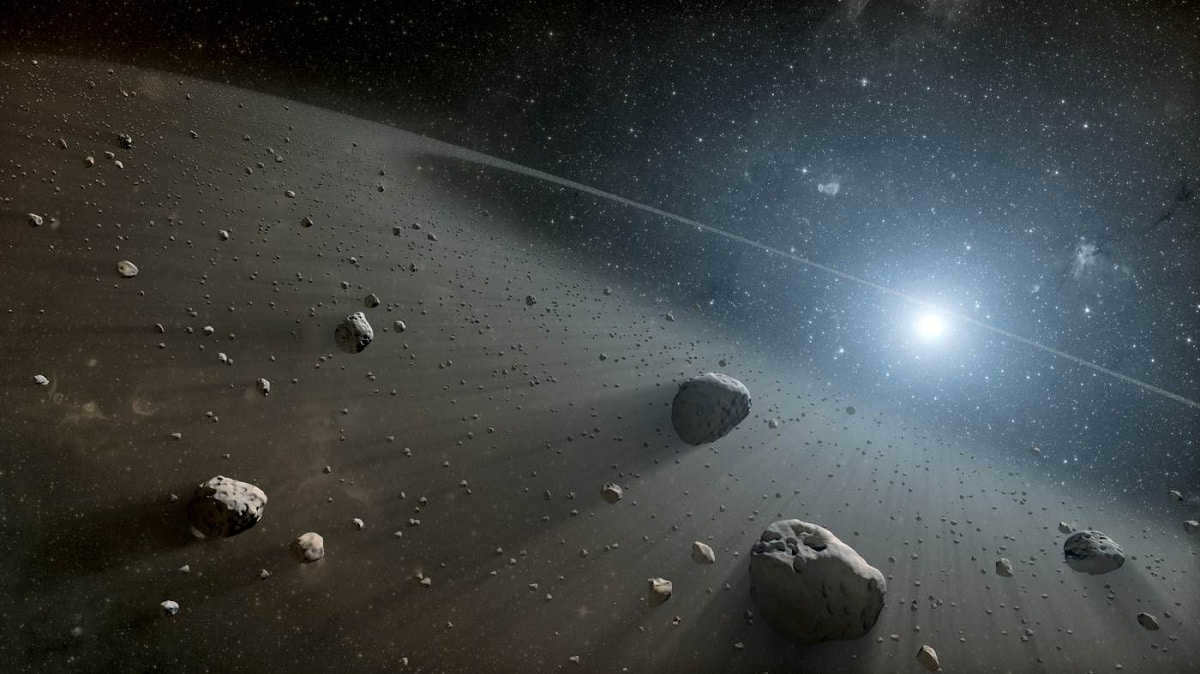
However, this situation may soon undergo a transformation. The scientific team has utilized extensive years of observations to thoroughly examine the surrounding celestial conditions. If these discoveries prove to be accurate, Vega could potentially host a significant number of exoplanets within its orbit. The proximity between the star and these potential exoplanets is so remarkably close that it takes a mere two and a half Earth days for a full revolution to occur. As a point of comparison, Mercury, the nearest planet to the Sun, requires 88 days to complete a single revolution. Additionally, another noteworthy aspect would be the extreme temperatures experienced in this environment.
With an average surface temperature of approximately 2976 degrees Celsius, it is one of the hottest exoplanets ever discovered. This finding also has implications for the search for other exoplanets in the Vega star system. Since this system is much larger than our own solar system, there is a possibility of other planets orbiting the star. Therefore, the main question is whether we have the technology to detect them.
Exoplanets
Exoplanets are celestial bodies that orbit stars outside of our own solar system. These planets have become a subject of great interest and research in the field of astronomy. Scientists use various methods to detect and study exoplanets, including the transit method, where the planet’s presence is detected by observing the slight dimming of its host star as it passes in front of it. The study of exoplanets has provided valuable insights into the formation and evolution of planetary systems, and has even led to the discovery of potentially habitable worlds. With advancements in technology, astronomers are now able to detect smaller and more distant exoplanets, bringing us closer to answering the age-old question of whether we are alone in the universe.
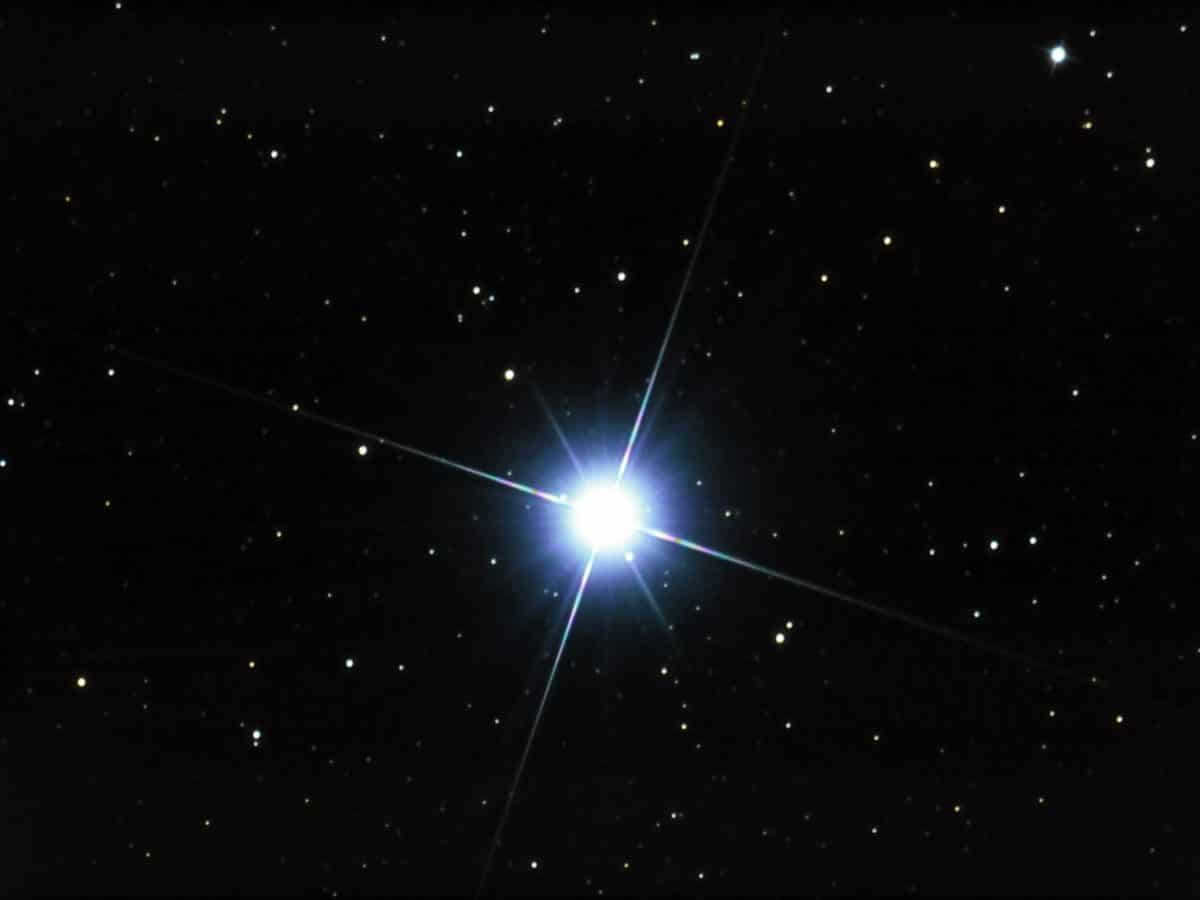
There have been over 4,000 exoplanets discovered to date. However, only a small number of these planets are truly captivating. Only a handful have been detected orbiting stars that are as luminous or as near to Earth as Vega. Therefore, the study of planets in the vicinity of Vega would provide a unique opportunity for in-depth exploration. Regardless of whether these planets are habitable or not, the discovery of an exoplanet around Vega would be significant news.
One theory takes an extreme approach and suggests that there could be a solid, rocky planet in the Vega star system. This is in contrast to what we know about the gas giant planet Jupiter. However, even if this rocky planet exists, it is unlikely to be a candidate for extraterrestrial life due to its location outside the habitable zone. It is fascinating to consider that this exoplanet could be inflated like a balloon, with its proximity to Vega’s star playing a role in this process. The extreme temperatures on this planet would be so high that even iron could melt in its atmosphere.
By learning about the star Vega, its characteristics, and its surroundings, we hope to gain a better understanding of this enigmatic celestial body.
This article adheres to our editorial ethics guidelines. If you spot any errors, please let us know by clicking here.
Read the full article summary on Network Meteorology: “Star Vega and the Fascinating Possibilities of Exoplanets”
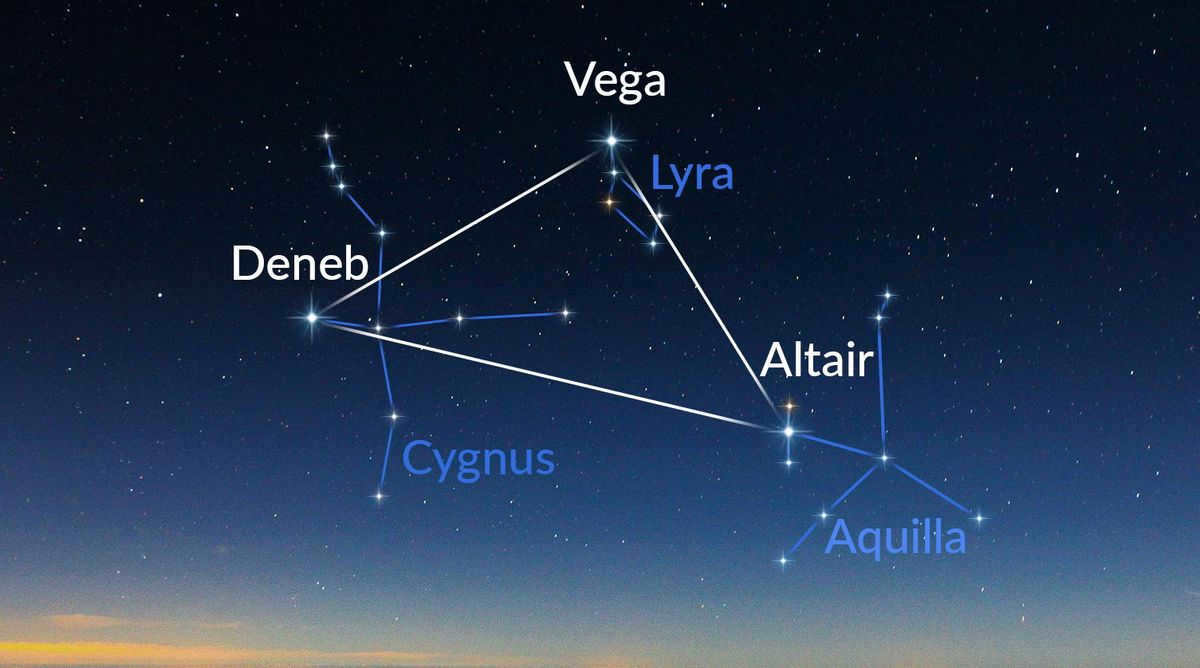
Vega is the most brilliant star in the Lyra constellation, and it is the fifth brightest star in general that is known to us. In terms of brightness, it is second only to Arcturus in the Northern Hemisphere. Its name originates from the Arabic word waqi, which means “falling eagle”. The ancient Egyptians represented the Lyra constellation as a vulture or eagle.
Vega has long been utilized as a benchmark for calibrating telescopic devices, earning it the moniker “the second most significant star after the Sun” among astronomers. This star is visible from nearly all locations on Earth, with the exception of Antarctica and southern South America. The optimal time to observe Vega is during the summer season, particularly in July when the conditions are ideal for stargazing the summer-fall asterism (triangle), of which Vega serves as the uppermost point.
Main characteristics
- Vega is an infrared star prototype, meaning it has a disk made of dust and gas that emits infrared light due to the star’s energy. The mass of this protoplanetary disk is roughly equivalent to 12 Jupiter masses.
- Vega is estimated to be around 460 million years old.
- It is located approximately 7.67 parsecs (25 light years) away from the Solar System.
- Vega has a mass of about 2.2 times that of the Sun.
- The star has a radius of about 2.73 times that of the Sun, with its polar radius being smaller than its equatorial radius (2.36 vs. 2.82).
- Vega has a surface temperature of around 9300 degrees Celsius, but it’s not evenly distributed and is much lower at the equator.
- The star rotates at an extremely fast speed of about 230 km/sec, which is significantly faster than the Sun’s rotation rate of just over 2 km/sec. This rapid rotation causes Vega to have an ellipsoid shape.
Astronomers have determined that Vega is making a gradual, yet steady, approach towards the Solar System. Currently, it ranks as the fifth brightest star, but in approximately 210,000 years, it will become the most brilliant star visible to the naked eye, holding this distinction for another 250,000-270,000 years.
Vega possesses a luminosity equivalent to about 37 times that of our Sun and exhibits a slight variability in brightness. Additionally, it stands out as one of the most luminous stars within a radius of 10 parsecs from the Sun (1 parsec is equivalent to 30.8568 trillion km).

There are several possible reasons why the star Vega has insignificant X-ray emission compared to others. One reason could be the absence of a corona or the weakness of its corona. Another reason is that Vega’s energy is fueled by the synthesis of helium from hydrogen.
Interesting facts about Vega
1. Vega stands out from most stars because of its ellipsoidal shape.
2. Vega holds several firsts among stars:
- First star to be photographed by a telescope (1850)
- First star to have its radiation spectrum determined (1872)
- First star to have its distance established by parallax (1837)
- First star to have a dust disk detected (1983)
3. Vega served as a reference point for many years, with zero apparent luminosity, for measuring the emission of other stars. These measurements are known as stellar magnitudes.
4. Vega’s composition is made up of only 0.54% heavy metals, indicating that it may have formed from a hydrogen cloud that lacked metals and cosmic dust.
5. It is believed that there may be another planet near Vega, possibly the size of Neptune. Additionally, it is speculated that the star has a companion. However, due to the star’s high brightness and distance from the solar system, it is impossible to accurately observe it even with the most powerful telescope.
6. One unique characteristic of Vega is that it never crosses the visible horizon line of the Northern Hemisphere.
7. Vega is the highest point of the “Summer-Autumn Triangle,” along with its companions Deneb and Altair. This triangle serves as a reference point to easily locate the other summer constellations in the sky. The Milky Way also passes through this area.
8. The Vega system was responsible for the alien signal in the science fiction film Contact. This star is often a popular choice among sci-fi writers.
9. Among the 15 stars selected by medieval astrologers for their significant influence on humanity.
10. Vega’s estimated lifespan is around 1 billion years, with the future possibility of the star eventually becoming a red giant and then a white dwarf.

Vega, known as the second most luminous star in the Northern Hemisphere, holds the fifth position in terms of brightness in the entire sky, surpassed only by Sirius and Arcturus.
In ancient times, the region of Lyra was depicted as an eagle or vulture. The name “Vega” itself translates to “falling eagle” or “falling vulture.”

Vega: The Star of Great Significance
Regarded by many astronomers as the second most significant star after the Sun, Vega has been the subject of extensive research. Its image was captured using solar observation techniques, and it holds the distinction of being the first star for which the radiation spectrum was determined. Moreover, the parallax method was employed to determine its distance for the first time.
Stars are the most precious entities in life. They don’t exist in the realm we journey to after death.
Chuck Palanick
Lullaby
Vega has become the most extensively studied celestial body in the universe. However, scientists continue to speculate about its nature, highlighting the vast amount of knowledge yet to be uncovered about the cosmos.
For instance, astronomers have a belief that Vega is a star that can change its brightness. This might be due to the lack of stability within its core. Additionally, there could potentially be a nearby celestial body in its vicinity.
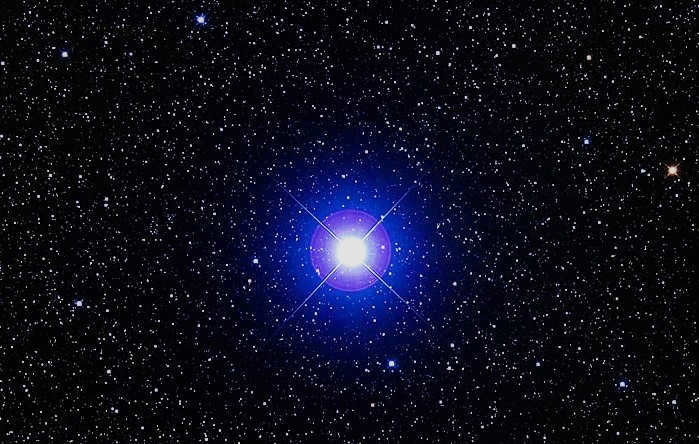
Fascinating information
It would be correct to state that Vega is a youthful entity. Despite being around for a considerable amount of time, approximately 450 million years.
Moreover, it falls under the classification of A0V. Thus, it is a white main-sequence celestial being. It undergoes a process known as thermonuclear fusion. In simpler terms, helium is produced from hydrogen inside the star under immense temperatures.

Helium, along with hydrogen, is the most abundant element in space.
Additionally, it possesses an enormous rotational velocity. Furthermore, the surface temperature of this celestial body is not uniform.
Unlike its counterparts, this star has an ellipsoidal form. Consequently, it is observed from Earth from its polar side.
“My thoughts are stars that I cannot gather into constellations.”
John Green
The stars are at fault
Incidentally, there are stars in astronomy that are referred to as Vega-like stars. These stars have a gas-dust disk that is visible in the infrared spectrum. Furthermore, scientists utilize this star as a reference for various characteristics.
Vega is a bright star, even in proximity to the Sun. Also, it is situated 25 light years away from it.
